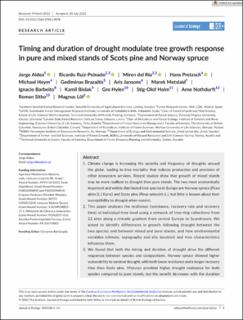| dc.contributor.author | Aldea, Jorge | |
| dc.contributor.author | Ruiz-Peinado, Ricardo | |
| dc.contributor.author | del Río, Miren | |
| dc.contributor.author | Pretzsch, Hans | |
| dc.contributor.author | Heym, Michael | |
| dc.contributor.author | Brazaitis, Gediminas | |
| dc.contributor.author | Jansons, Aris | |
| dc.contributor.author | Metslaid, Marek | |
| dc.contributor.author | Barbeito, Ignacio | |
| dc.contributor.author | Bielak, Kamil | |
| dc.contributor.author | Hylen, Gro | |
| dc.contributor.author | Holm, Stig-Olof | |
| dc.contributor.author | Nothdurft, Arne | |
| dc.contributor.author | Sitko, Roman | |
| dc.contributor.author | Löf, Magnus | |
| dc.date.accessioned | 2022-10-10T14:07:37Z | |
| dc.date.available | 2022-10-10T14:07:37Z | |
| dc.date.created | 2022-08-30T10:34:32Z | |
| dc.date.issued | 2022-08-08 | |
| dc.identifier.citation | Journal of Ecology. 2022, . | en_US |
| dc.identifier.issn | 0022-0477 | |
| dc.identifier.uri | https://hdl.handle.net/11250/3025178 | |
| dc.description.abstract | 1. Climate change is increasing the severity and frequency of droughts around the globe, leading to tree mortality that reduces production and provision of other ecosystem services. Recent studies show that growth of mixed stands may be more resilient to drought than pure stands. The two most economically important and widely distributed tree species in Europe are Norway spruce (Picea abies (L.) Karst) and Scots pine (Pinus sylvestris L.), but little is known about their susceptibility to drought when coexist. 2. This paper analyses the resilience (resistance, recovery rate and recovery time) at individual-tree level using a network of tree-ring collections from 22 sites along a climatic gradient from central Europe to Scandinavia. We aimed to identify differences in growth following drought between the two species and between mixed and pure stands, and how environmental variables (climate, topography and site location) and tree characteristics influence them. 3. We found that both the timing and duration of drought drive the different responses between species and compositions. Norway spruce showed higher vulnerability to summer drought, with both lower resistance and a longer recovery time than Scots pine. Mixtures provided higher drought resistance for both species compared to pure stands, but the benefit decreases with the duration of the drought. Especially climate sensitive and old trees in climatically marginal sites were more affected by drought stress. 4. Synthesis. Promoting Scots pine and mixed forests is a promising strategy for adapting European forests to climate change. However, if future droughts become longer, the advantage of mixed stands could disappear which would be especially negative for Norway spruce. | en_US |
| dc.description.abstract | Timing and duration of drought modulate tree growth response in pure and mixed stands of Scots pine and Norway spruce | en_US |
| dc.language.iso | eng | en_US |
| dc.publisher | John Wiley & Sons Ltd on behalf of British Ecological Society | en_US |
| dc.rights | Attribution-NonCommercial-NoDerivatives 4.0 Internasjonal | * |
| dc.rights.uri | http://creativecommons.org/licenses/by-nc-nd/4.0/deed.no | * |
| dc.title | Timing and duration of drought modulate tree growth response in pure and mixed stands of Scots pine and Norway spruce | en_US |
| dc.title.alternative | Timing and duration of drought modulate tree growth response in pure and mixed stands of Scots pine and Norway spruce | en_US |
| dc.type | Peer reviewed | en_US |
| dc.type | Journal article | en_US |
| dc.description.version | publishedVersion | en_US |
| dc.rights.holder | © 2022 The Authors | en_US |
| dc.source.pagenumber | 11 | en_US |
| dc.source.journal | Journal of Ecology | en_US |
| dc.identifier.doi | 10.1111/1365-2745.13978 | |
| dc.identifier.cristin | 2047060 | |
| dc.relation.project | EC/H2020/778322 | en_US |
| dc.relation.project | EC/FP7/606803 | en_US |
| cristin.ispublished | true | |
| cristin.fulltext | original | |
| cristin.qualitycode | 2 | |

